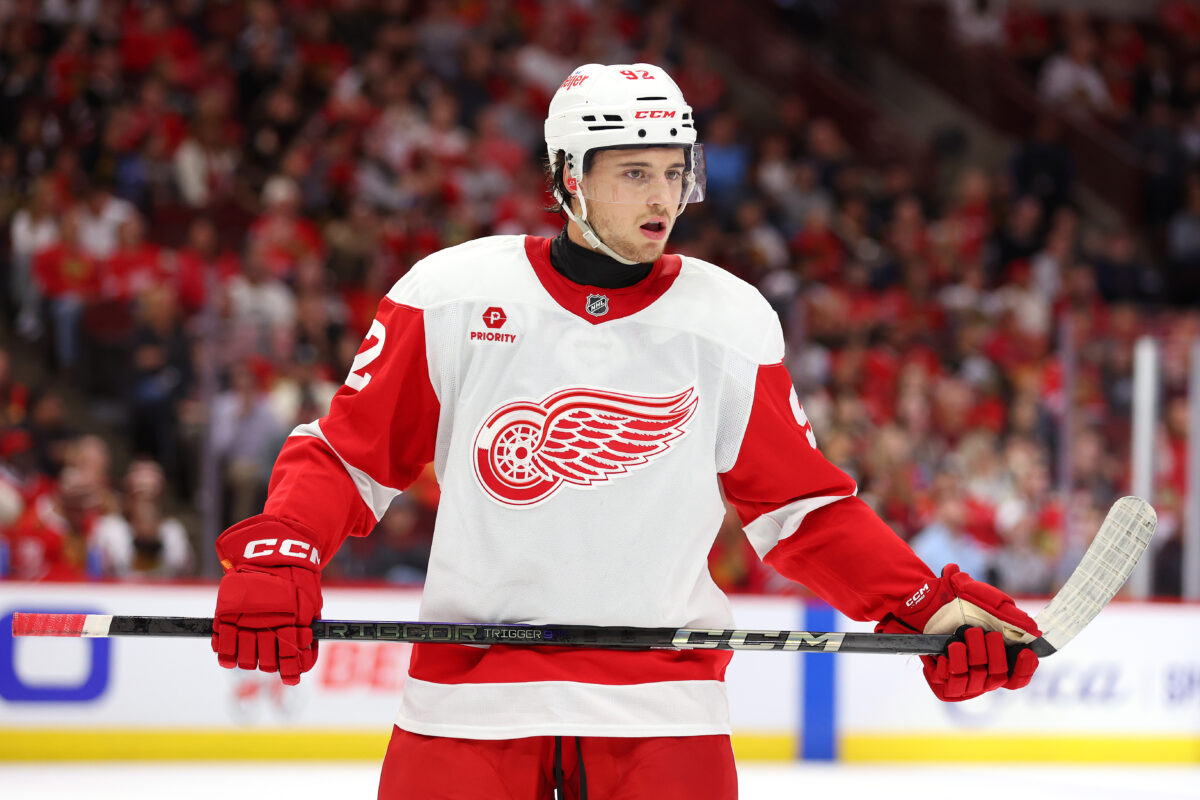The Detroit Red Wings’ 2025–26 preseason didn’t just feel different; it looked different. With fresh faces, internal battles, and systems taking shape, the Red Wings entered the exhibition slate under head coach Todd McLellan with more expectation than in recent years. The results? A mix of strong outings, standout performances, and glimpses of a team ready to compete.
Preseason Recap
Detroit opened its preseason on Sept. 23 at Little Caesars Arena with a tight 3–2 victory over the Chicago Blackhawks. Emmitt Finnie (one goal, one assist) and Michael Brandsegg-Nygård (two assists) lit things up in that game, combining for the offensive spark Detroit needed.
Related: How the Red Wings Turned Their Special Teams Weakness Into a Weapon
On Sept. 25, the Wings faced the Buffalo Sabres and cruised to a 5–2 win. Notably, Lucas Raymond tallied two assists, and Andrew Copp added a goal and an assist. That performance built confidence and gave Detroit some legitimacy among preseason winners.
Later in the preseason, Detroit dropped a tight 2–1 game to the Pittsburgh Penguins, where John Gibson started and showed flashes of the form that earned him the crease. It was a close one, but the Wings showed they could battle even when trailing.
The Red Wings opened their preseason series against the Toronto Maple Leafs on Oct. 2 at Scotiabank Arena with a 3–1 win fueled by a strong third period. After falling behind on an Auston Matthews power-play goal, Dylan Larkin tied it early in the final frame before Alex DeBrincat and Finnie sealed the victory. Detroit’s defensive structure tightened late, shutting down Toronto’s top scorers and showcasing the poise they’ll need heading into the regular season.
Two nights later at Little Caesars Arena, Detroit capped the preseason with a thrilling 6–5 overtime win over Toronto. Larkin and Brandsegg-Nygård each scored twice, while Patrick Kane added three points in a vintage showing. Albert Johansson tied it with 31 seconds left, and Larkin buried the overtime winner on the power play to complete the comeback, a fitting display of the Red Wings’ depth, resilience, and offensive flair heading into the regular season.

Between those matchups, Detroit held its Red & White Game in Grand Rapids, selling out Van Andel Arena and giving fans a final look at camp bearers and fringe players. The intrasquad scrimmage, followed by a shootout, was a fitting close to training camp.
Depth Earned Its Chance
This preseason, unlike so many before it, was not just about the stars. Detroit leaned hard on internal competition. Many forwards, defensemen, and goalies saw meaningful minutes, and the ability to roll three competitive lines on many nights helped solidify the notion that the roster is deeper and more capable than it has been in recent seasons.
Veteran Leadership
Larkin, Raymond, and DeBrincat all showed early signs of a dominant 2025-26 campaign. Their puck movement, zone pressure, and ability to tilt the ice carried weight in Detroit’s best moments. Kane, J.T. Compher, and Andrew Copp also contributed in subtle but impactful ways; veteran leadership and playmaking that complement the younger core, as Marco Kasper continues to grow into a top center on the team.
Defensive Growth (Despite Absences)
Detroit faced a hurdle when Simon Edvinsson was sidelined from training camp and the preseason due to a lower-body injury. His absence put pressure on the rest of the blue line to step up, and they responded. Moritz Seider and Edvinsson’s partners (Ben Chiarot, Edvinsson’s backups, etc.) filled in with poise. The team also used the scramble to test depth options and small-pairing combinations.
Goaltending Battle Heating Up
One of the most compelling storylines was how the crease would be handled. Gibson showed sharpness: in his appearances, he turned aside a high percentage of shots and made highlight-level saves under traffic. Sebastian Cossa, meanwhile, earned experience in relief, showing flashes of confidence and readiness for future responsibility.
What It All Suggests for the Regular Season
Preseason is a sandbox, but Detroit built something out of it this year: confidence. They didn’t just win games; they showed process. Systems are sticking. Depth is real. Top lines carry weight. The blue line held up even when tested. Goaltending looks competitive.
Detroit’s record may not be the full story, but the approach is. As the Red Wings shift into October mode, the lessons from preseason should fuel their starts rather than fade away.
